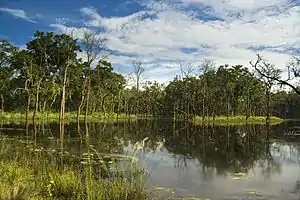ချစ်ဝမ်အမျိုးသားဥယျာဉ်
ချစ်ဝမ်အမျိုးသားဥယျာဉ် သည် နီပေါနိုင်ငံ၏ ပထမဆုံး အမျိုးသားဥယျာဉ်တစ်ခု ဖြစ်ပြီး ၁၉၇၃ ခုနှစ်တွင် တည်ထောင်ခဲ့ကာ ၁၉၈၄ ခုနှစ်တွင် ယူနက်စကိုမှ ကမ္ဘာ့အမွေအနှစ်နေရာ အဖြစ် သတ်မှတ်ခဲ့သည်။ ၎င်းသည် အကျယ်အဝန်းအားဖြင့် ၃၆၀ စတုရန်းမိုင် (၉၃၂ စတုရန်းကီလိုမီတာ) မျှ ရှိပြီး နီပေါနိုင်ငံ တောင်ဘက်အလယ်ပိုင်းရှိ အပူပိုင်းဆန်သော အတွင်းပိုင်း တီရိုင်းမြေနိမ့်ဒေသတွင် တည်ရှိကာ နာဝါပူ၊ ပါဆာ၊ ချစ်ဝမ် နှင့် မက်ဝမ်းပါ ပြည်နယ်များအတွင်း တည်ရှိသည်။ အမြင့်အားဖြင့် တောင်ကြားမြစ်ဝှမ်းဒေသများတွင် အနိမ့်ဆုံး ၃၃၀ပေ (၁၀၀ မီတာ) မှ ချူရီယာတောင်ကုန်းများတွင် ၂၇၆၄ ပေ (၈၁၅ မီတာ) မျှ ရှိသည်။[1]
| ချစ်ဝမ် အမျိုးသားဥယျာဉ် | |
|---|---|
| Chitwan National Park | |
IUCN category II (အမျိုးသားဥယျာဉ်) | |
 ချစ်ဝမ်ရှိ ဘီရှာဇာရီတဲလ် ကန် စနစ် | |
| တည်နေရာ | နီပေါနိုင်ငံ |
| ဖွဲ့စည်း | ၁၉၇၃ |
| အမျိုးအစား | သဘာဝ |
| ရွေးချယ်သည့်စံနှုန်း | vii, ix, x |
| ရွေးချယ်ခြင်း | ၁၉၈၄(အဋ္ဌမအကြိမ်) |
| ရည်ညွှန်းနံပါတ် | 284 |
| နိုင်ငံ | နီပေါနိုင်ငံ |
| ဒေသ | အာရှနှင့်ပစိဖိတ် |
ထိန်းသိမ်းထားသော နယ်မြေ၏ မြောက်ဘက်နှင့် အနောက်ဘက်တွင် နာရာယာနီ-ရာပတီ မြစ်များက လူတို့နေထိုင်ရာများနှင့် သဘာဝ နယ်နိမိတ်အဖြစ် ပိုင်းခြား သတ်မှတ်ထားသည်။ ချစ်ဝမ်အမျိုးသား ဥယျာဉ်၏ အရှေ့ဘက်တွင် ကပ်လျှက် တည်ရှိသည်မှာ ပါဆာအမျိုးသား ဥယျာဉ်ဖြစ်ပြီး တောင်ဘက်တွင် တစ်ဆက်တည်းရှိသည်မှာ အိန္ဒိယနိုင်ငံ၏ ကျားထိန်းသိမ်းရေးနယ်မြေ ဖြစ်သော ဗာလ်မီကီအမျိုးသား ဥယျာဉ် ဖြစ်သည်။ တစ်ဆက်တည်းဖြစ်သော ထိန်းသိမ်းရေးနယ်မြေမှာ ၈၀၁ စတုရန်းမိုင် (၂,၀၇၅ စတုရန်းကီလိုမီတာ) မျှ ရှိပြီး ကျားထိန်းသိမ်းရေး ယူနစ် ၊ ချစ်ဝမ်-ပါဆာ-ဗာလ်မီကီ အဖြစ်ရှိကာ ၎င်းမှာ ၁,၃၇၀ စတုရန်းမိုင် (၃,၅၄၉ စတုရန်း ကီလိုမီတာ) မျှ ရှိပြီး အလွန်ကြီးမားသော နုန်းမြေမြက်ခင်းပြင်နှင့် အပူပိုင်းဆန်၍ စိုစွတ်သော ရွက်ကြွေတောများ ပါဝင်သည်။ [2]
- ချစ်ဝမ်အမျိုးသားဥယျာဉ်








ကိုးကား
- Bhuju, U. R., Shakya, P. R., Basnet, T. B., Shrestha, S. (2007)။ Nepal Biodiversity Resource Book. Protected Areas, Ramsar Sites, and World Heritage Sites (PDF)။ Kathmandu: International Centre for Integrated Mountain Development, Ministry of Environment, Science and Technology, in cooperation with United Nations Environment Programme, Regional Office for Asia and the Pacific။ ISBN 978-92-9115-033-5။CS1 maint: uses authors parameter (link)
- Wikramanayake, E.D., Dinerstein, E., Robinson, J.G., Karanth, K.U., Rabinowitz, A., Olson, D., Mathew, T., Hedao, P., Connor, M., Hemley, G., Bolze, D. (1999) Where can tigers live in the future? A framework for identifying high-priority areas for the conservation of tigers in the wild. Archived March 10, 2012, at the Wayback Machine. In: Seidensticker, J., Christie, S., Jackson, P. (eds.) Riding the Tiger. Tiger Conservation in human-dominated landscapes. Cambridge University Press, Cambridge. hardback ISBN 0-521-64057-1, paperback ISBN 0-521-64835-1.